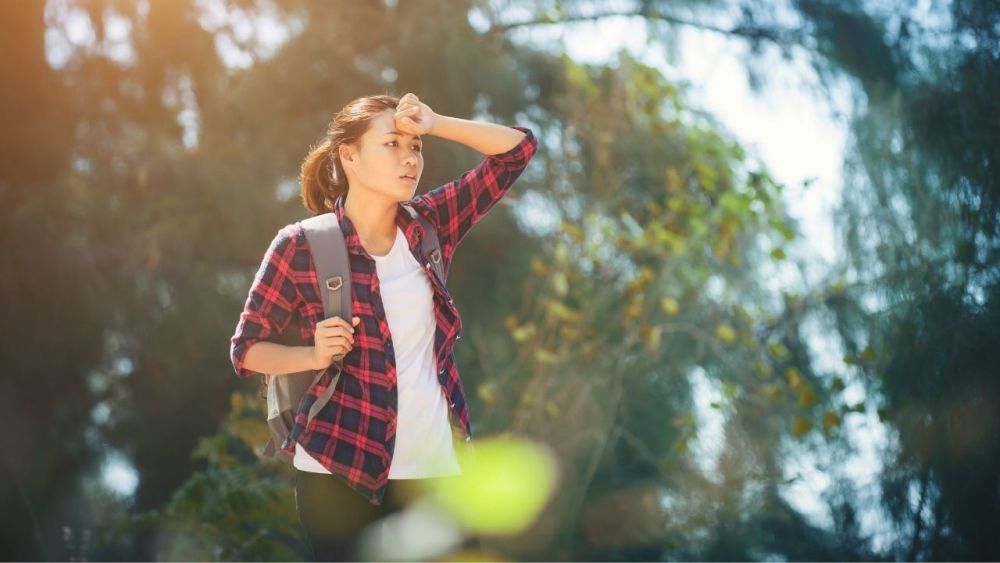
9 great tips for hiking in hot weather.
👉 The key facts from this guide
- Plan your hike for shade and water: Choose wooded routes and shorter or easier trails.
- Don't overdo it: Know your limits and avoid overexertion in the heat.
- Drink plenty of water and maintain your electrolyte balance: Bring enough water and electrolyte replacement supplements.
- Eat protein-rich snacks: Nuts, jerky, dried fruits, and protein bars are suitable options.
- Avoid hiking during the hottest times of the day: Plan hikes for early morning or evening.
- Wear sun protection: Use sunscreen, a wide-brimmed hat, and lightweight long-sleeved shirt.
Summer is the best time for hiking: It is dry and the forests and meadows are green.
But unfortunately, that also means it can get damn hot.
Some of my hiking friends are highly sensitive to heat, but they still want to go hiking even when it's too hot outside.
After years of experience (and some not so great outings where the heat got to me too), here are my tips for hiking in hot weather.
1. Plan your hike for shade and water
A hot day with lots of sunshine is not necessarily the best day for hiking on mountain ridges or mountain peaks that are fully exposed to the sun.
Choose a wooded hike with plenty of shade in hot weather. When it's very hot outside, you'll get tired faster, so you should decide on a shorter or easier route than usual.
When it's really hot outside, I also like to select a hike near a river or lake.
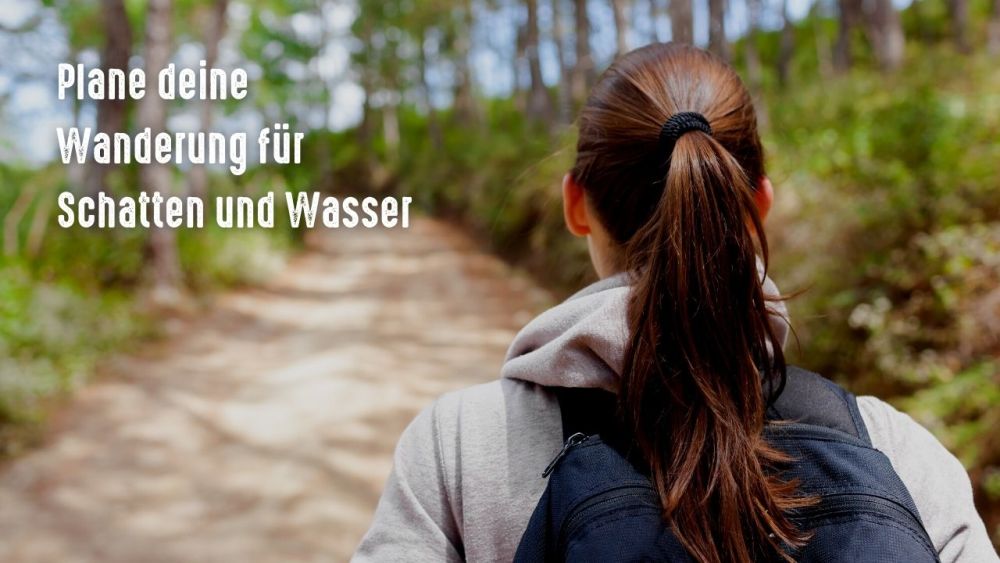
Near water, the air is often cooler, which can be very refreshing. Additionally, the best way to cool off is by jumping into the cool water.
Leave No Trace Tip: Make sure to wipe off sunscreen or insect repellent beforehand to avoid harming plants and fish.
2. Don't overdo it
Regardless of the activity, it is important for people to know their limits and do their best not to overexert themselves.
If the path is difficult during your hike and heat exhaustion is getting to you, it is essential to remember that the way out will be even more challenging.
By planning a strenuous hike or deciding to extend the hike at the last minute, hikers expose themselves to a greater risk of heat exhaustion and ultimately heat stroke.
3. Drink plenty of water
During extreme heat, you can quickly become dehydrated. The body cools down by sweating, and at high temperatures, you sweat profusely.
If you don't replace this sweat with water, you will become dehydrated.
The symptoms of dehydration include increased thirst and less frequent urination at best. In the worst case, it can lead to headaches, dizziness, nausea, fatigue, confusion, and vomiting. That's no fun.
Take plenty of water with you. How much you should take depends on how hot it is outside, how far you want to hike, and can also vary from person to person.
But keep in mind that some people may need to consume up to 1 liter of water per hour while hiking in hot weather. That's a lot!
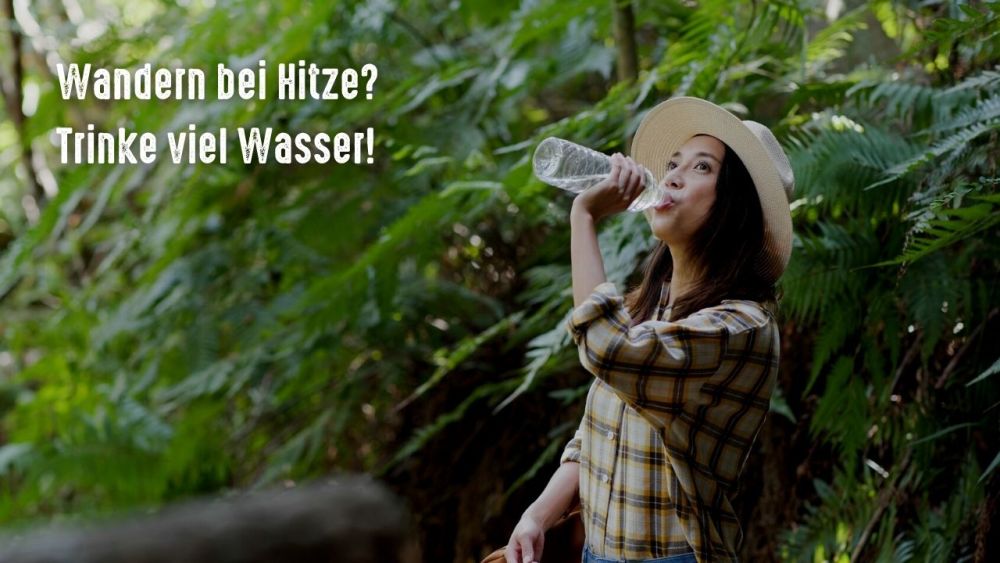
If I aim to hike in hot weather, I often plan to get some water along the way instead of carrying everything (water is heavy!).
I'm doing some research and looking for a way to a reliable water source.
And of course, I bring water purification drops or a water filter with me so that I can treat the water before drinking it.
I use the Katadyn Pocket water filter (read my review here) for longer hikes or multi-day trips.
Recommendation: Check out the water purification drops, water purification tablets, and water filters from Katadyn. The Pocket Filter and the Vario Filter are excellent for water treatment.
4. Maintain your electrolyte balance
Drinking water alone is not enough to maintain fluid balance.
We all know that sweat contains salt (also known as sodium). But did you know that it also contains potassium and other minerals known as electrolytes?
If your electrolyte balance is depleted, you can experience similar symptoms to dehydration, with the added disadvantage of muscle cramps. Definitely not fun.
To avoid an electrolyte deficiency, you should drink a sports drink like Gatorade, which also contains sodium, potassium, and other minerals.
But bottled sports drinks are heavy, expensive, and often contain too much sugar.
Alternatives in powder or tablet form can be much cheaper. Additionally, they are easy to take with you, so you can add them to water on the go and adjust the strength of the mixture individually.
5. Eat protein-rich snacks
It is difficult for the body to absorb water when it does not have any food or additional energy to take it in.
Therefore, protein-rich snacks are essential for a hike, especially in hot weather.
Things like nuts, jerky, dried fruits, and protein bars should be sufficient.

6. Avoid hiking during the hottest times of the day
It is usually hottest in the afternoon, around 3 or 4 PM.
That's because the sun has heated the ground extremely after noon. And in Central Europe, the sun is not exactly at its highest point at noon, but in the early afternoon.
Instead of hiking in the heat, you might want to consider planning a hike to watch the sunrise so that you're back home in time for lunch.
Or take a hike to watch the sunset after dinner. In both cases, don't forget to bring a headlamp.
Generally, the following times of day are good for hiking:
- in the early morning (between sunrise and 9:00 a.m.)
- in the morning until noon (between 9:00 a.m. and 2:00 p.m.)
- in the afternoon (between 2:00 p.m. and 5:00 p.m.)
- in the evening (between 5:00 p.m. and 8:00 p.m.)
- at night (between sunset and sunrise)
7. Wear sunscreen
A sunburn is a sure way to feel even hotter than it already is.
Wearing sunscreens is always a promising idea when hiking, but on a really hot day, it can become challenging as sweat washes them off.
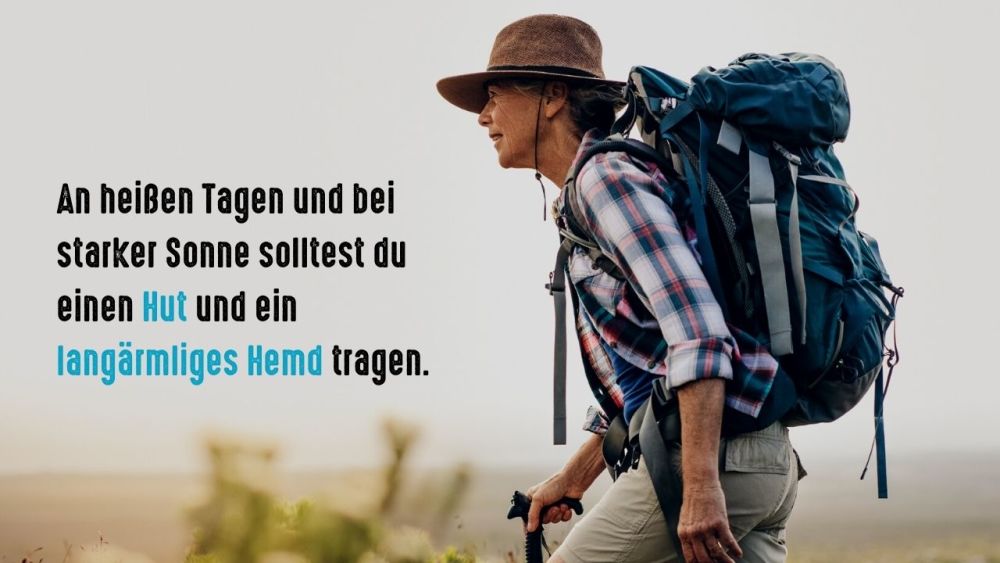
You can try using sweat-resistant sport sunscreen, but you still need to reapply it frequently.
Instead of exposing a lot of skin and relying on sunscreen, you can also wear a hat (read more about head coverings) with a wide brim and a lightweight long-sleeved shirt for sun protection.
If your sweat soaks your hat and shirt, it actually keeps you cool!
Read also
Survival in summer: Surviving extreme heat without air conditioning (+ tips for the desert) - It's hot where you are, there's a heatwave, and you don't have an air conditioner? Find survival tips here for dealing with heat in the city, in the forest, and in the desert.
8. Manage your sweat
When it's hot, you inevitably sweat. As I mentioned before, sweating depletes electrolytes and washes off sunscreen.
But there are a few other ways in which sweating can affect your hike.
Sweat on the face
First, it gets into the eyes, and that burns! I have a small towel with me that I can use to wipe my forehead, but a scarf works too.
I use a face towel from PackTowl. It is a travel towel made of microfiber that dries quickly and has a loop attached, so you can easily attach it to your backpack.
Sweaty Feet
Secondly: If you have sweaty feet, it can lead to blisters.
Wear well-ventilated hiking shoes if possible (on hot, dry days you don't need thick, waterproof leather hiking shoes).
Choose socks made of synthetic or wool blends that breathe well and do not absorb moisture. Bring extra socks to change into halfway through.
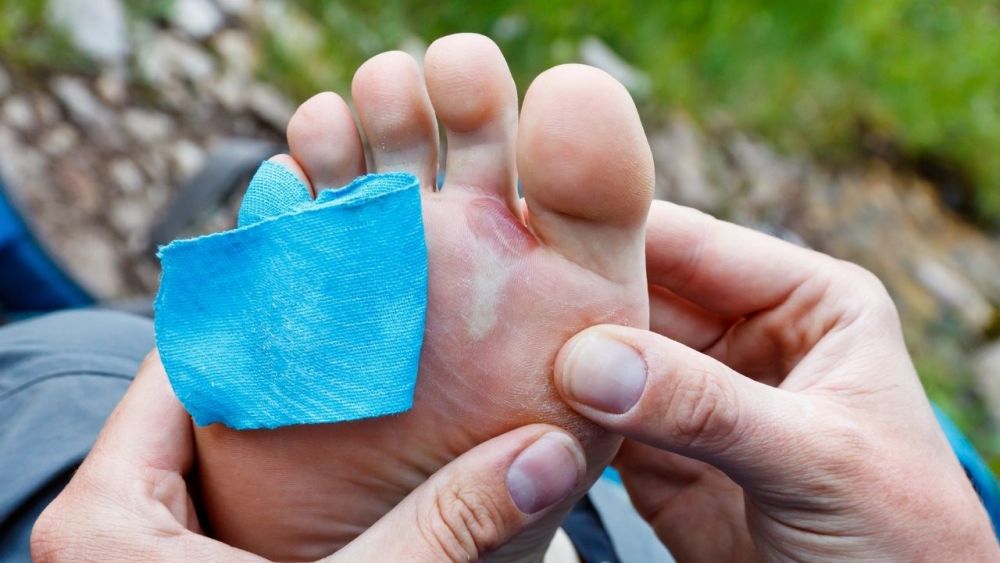
Pack additional plasters and blister dressings and make sure to stop and treat any hot spots on your feet at the first sign. Don't wait until you have a huge blister.
Do you require more tips on blisters on your feet? I have a guide on how to prevent blisters.
Chafing
And finally, the worst reason why sweating can occur while hiking in hot weather: chafing.
If you have never experienced chafing while hiking, consider yourself lucky. Chafing occurs when the skin and clothing becomes moist from sweat or rain and then rubs against each other.
Frequent areas where chafing occurs are the buttocks, groin, and feet. So, the hilarious spots!
To avoid chafing, you should choose to hike clothing made of synthetic fibers such as polyester or nylon, which do not absorb as much water as cotton or wool.
Of course, this also applies to your underwear!
When it comes to underwear and sports bras, seek seamless options or those with flat seams.
Men should consider wearing underwear that uses a pouch (called pouch underwear) to separate the genitals from the legs.
Women who experience chafing on the inner thighs can also opt for underwear in the style of boxers or boyshorts, which provide a little coverage.
If you know that you sweat a lot and are prone to chafing, you should get an anti-chafing lubricant. Apply it before your hike for prevention and maybe even bring it along to reapply.
This stuff has literally saved my wife's butt more than once.
If you should get sore, go to the baby department of the drugstore and buy a diaper rash cream.
Read also
Why do people wear long, black clothing in the desert? - In the desert, the population wears long black garments, usually made of thick fabrics. Why don't they wear a T-shirt and instead wear black clothing?
9. Recognize and treat heat stroke correctly
A heatstroke is no joke. It can even be deadly or damage your organs.
A heatstroke occurs when the body temperature becomes too high (above 40 °C).
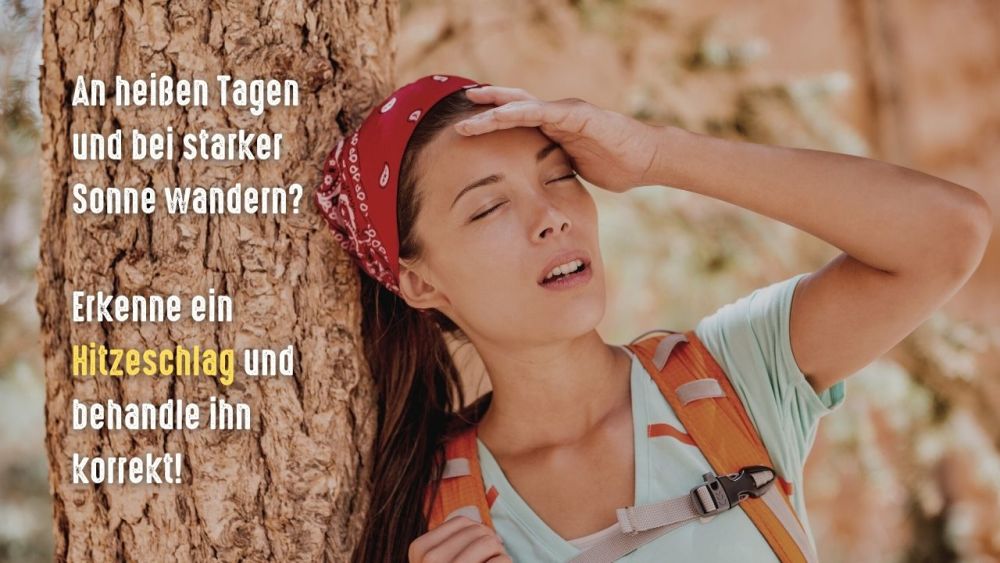
The symptoms of heatstroke include:
- Headache
- Dizziness
- Nausea
- Vomiting
- Lack of sweating despite the heat
- Hot feeling skin
- Muscle cramps
- Rapid heartbeat
- Rapid breathing
- Confused behavior
In the worst case, seizures and unconsciousness can occur.
During a vacation in Tunisia, I once had a mild heatstroke. I felt weak and dizzy and had to vomit.
If you believe someone is experiencing heatstroke, seek medical attention immediately.
What you can do in case of heat stroke
In Africa, our tour guide poured cold water over me and then helped me walk a short distance to a bar, where I sat in the shade and drank a cola.
I rested for a few hours, and my temperature dropped enough that I could continue the excursion, even though I felt weak.
Here are my tips on what you should do to prevent heat stroke while hiking:
Treating Heat Exhaustion
If signs of heat stroke occur, it is imperative that the symptoms be treated immediately. Untreated symptoms can quickly develop into heat stroke, which can even be fatal. Applying these treatments and discontinuing the journey as soon as heat exhaustion occurs are the best ways to ensure that everyone returns from the excursion without serious harm.
Go into the shadows
The first step to cooling down the body is to seek shade. It is necessary to go into a gorge, under a cliff, under a tree, or to another safe and shady place. For additional cooling, a shady spot with a gentle breeze is best.
Remove restrictive clothing
While it is best to cover the skin to prevent heat stroke, it is also best to remove tight clothing. This is necessary to allow air and a cool breeze to reach the skin. You should only do this in the shade, not where the sun can further damage the skin.
Diving into Water
In the wild, you can observe animals bathing on hot days. They don't do it for fun, it is actually one of the best ways to cool down their bodies. The cool water helps to lower their body temperature, which speeds up the recovery from heatstroke.
Take a break
While waiting for the symptoms of heat stroke to pass, it is important to rest for a long time. Be sure to find a shady spot, sit or lie down, and make yourself comfortable. Drink water slowly.
Groups at risk for heat stroke
Nobody is immune to heat stroke, but there are some groups that are more susceptible to it. Those who fall into one of these groups needs to take extra precautions before going outdoors. They should also spend only a short time outdoors, especially in hot weather.
Inexperienced Hikers
The most dangerous qualities of a hiker are inexperience and overconfidence. Overzealous hikers tend to stay outdoors for too long, get lost along the way, or find themselves in a dangerous situation.
Small children and elderly people
It's great for younger and older generations to go out and explore nature, but they are often more susceptible to heat stroke. Additionally, they may have a harder time recovering from heat stroke. Therefore, they have an increased risk of developing heat stroke. Older hikers and hikers with young children should plan for shorter hikes and hike in cooler temperatures.
Highlanders
Hiking at high altitudes is much more challenging than at lower altitudes. While the temperature may be slightly cooler, the air is thinner, and it is much harder to breathe. If the sun is also beating down, it can be a recipe for disaster. Hikes at high altitudes should be done in cooler weather, be shorter, or only be attempted by well-experienced hikers.
Summary
Hiking in the heat can be dangerous if you don't know how to help yourself.
I have now given you dozens of tips and tricks to make hiking on a hot day enjoyable.
So don't let the heat stop you, go for a hike even on a hot day.
What are your best tips for hiking in hot weather? Please let me know in the comments.


Author of the guide
Martin Gebhardt
Hey, I'm Martin. On my blog, you will learn the basics and numerous details about living in the wild. I think survival, bushcraft and the good life in nature are the keys to happiness. Find me here on Instagram or on YouTube. You can find more about my mission on the About Me page.
Was this guide helpful?
16 people found this guide helpful.
5.00 out of 5 points (16 Ratings)
Comments (0)
This post may contain affiliate links. So if you click on the links and make a purchase, I will receive a small commission at no additional cost to you. Click here, to learn more about it.


